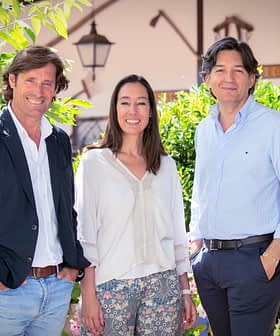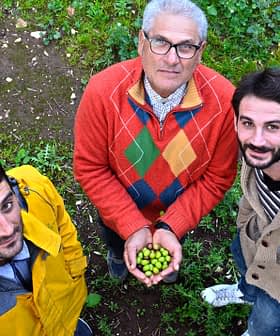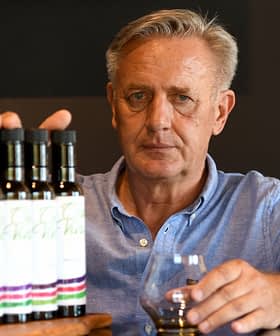Monterosa Looks to the Future with Eye on the Past
Deep in the quiet sun-scorched hills surrounding the town of Montcarapacho, Monterosa’s philosophy has led it more than once to make the most of the unexpected.
 Eduardo Martins and José Dâmaso
Eduardo Martins and José DâmasoLong before Portugal’s Algarve was a tourist destination, deep in the quiet sun-scorched hills surrounding the town of Montcarapacho, olive orchards thrived. Ancient Romans pressed their oil right here, leaving millstones, ruins, and thousand-year-plus olive trees behind.
We have invested so much time and patience in this small business, for us it’s an act of love to be shared.
For Viveiros Monterosa, EVOO production is much younger; making it the equivalent of a high school standout in an ancient sport. Since their first tentative official EVOO testing in 2009, Monterosa has risen to repeat Gold Awards four years in a row at the New York International Olive Oil Competition, competing with 910 participants from 27 countries. “We’re proud that,” sales representative António Duarte informs me, as we amble through their olive orchards.
Elegant palm trees line the entrance road leading to the clay-color home where company founder Detlev Von Rosen lived and worked; the brand name Monterosa is a Portuguese transliteration of his surname. Twenty yards away, the ruins of an ancient Roman olive mill have been tastefully integrated into the current operations, an apt visual affirmation of Monterosa’s goal to retain the ancient “tradition of making olive (that) has almost been lost.”
On our walk, Duarte brings up the company’s utilization of Roman Senator Marcus Cato’s manual on farming, De Agri Cultura; “he calibrated the ideal spacing between olive trees, five by seven meters apart, so they do not compete for water. And just so, we’ve set them.” Ancient wisdom is plainly poised as Monterosa’s foundation.

António Duarte
The past year has been bittersweet for Monterosa. EVOO production met exceptionally high-quality ratings, in competitions, while tasting tours and visits to Monterosa olive grove and press reached a record 2,500 visitors. And Detlev Von Rosen died.
See Also:Detlev Von Rosen, Portugal’s Celebrated Producer, Dies
His house sits empty, but his legacy thrives on location in the hands of long time collaborators and Monterosa shareholders CEO Eduardo Martins and CFO José Dâmaso, and newer associate Duarte.
From the pave stoned terrace overlooking the olive groves, Martins invokes Monterosa’s hopes for the future. “Of course, we’re looking to expand production, as our trees continue maturing. Another essential value for us is to show what it is to farm, broadening the picture to include our multiple horticultural endeavors. What if in this beautiful spot we offered wine, tea, fresh lemon juice, and maybe select overnights stays in the house?” he mused.

Orchard view at Monterosa
“Critical, for us, though, is avoiding aggressive touristic promotion. You see, we have invested so much time and patience in this small business, for us it’s an act of love to be shared.” We meander past red clay hillocks dotted with scented thyme, “they hold back erosion; a much better alternative to grass.” He and Dâmaso escort me through lush landscaping and exotic tree species, such as a Kenyan Terminalia, atypical of most olive farms. “We started this business in ornamental plants, and it remains core.” Monterosa does not live by olive trees alone.
In De Agri Cultura, Cato wrote: “… it is from the farming class that the bravest men and the sturdiest soldiers come, their calling is most highly respected, their livelihood is most assured.” But the stars do not always align even for the most ardent farmers.
In 1997 and 1998, serious drought made Monterosa’s livelihood anything but assured. Where olive orchards now stand, withering orange groves, in particular, were depleting irrigation wells. Martins recounts, “We almost ran out of water. Then we did the numbers, realizing it took 1,000 glasses of water to produce one glass of orange juice. This was unsustainable.”

Eduardo Martins and José Dâmaso
This twist of fate, ironically, jump-started a turnaround that, seventeen years later, is Monterosa’s prize-winning EVOO. Behind its pure smooth taste, swirls the back story of collapse, risk, reinvention, and serendipity.
“We immediately explored fruit cultivars native to our region climatically and geologically so similar to Andalucia: carob, almond, fig, olive. We gambled that if we couldn’t produce good olive oil, at least we had an ornamental olive tree to sell. Thing is, we knew a lot about trees, but a lot less about olive oil production.”
Over the following decade, the Monterosa team collaborated step-by-step with the laboratories of olive oil specialist Jose’ Gouveia, from ISA (Instituto Superior de Agronomia). In 2009, he recommended they compete in an official EVOO judging. Fate morphed, fortuitously netting Monterosa its first silver award.
Monterosa continues to be unwavering in its dedication to an environmentally sustainable integrated system that uses no chemical or synthetic products for pest control, strives for the lowest possible carbon footprint, and fashions compost from its own recycled pulp, grass clippings, and finely shredded prunings.

Inspecting the compost at Viveiros Monterosa

Monterosa Picual (Photo: NYIOOC)
In late spring/early summer, one aspect of the integrated system is particularly visible; the olive trees are coated a ghostly white. Exuberantly, Martins explains: “Our team observed that olive trees situated along the walls got coated with road dust, and were ignored by the fruit flies. Upon conferring with agricultural specialist Paul Vossen, we borrowed a pest control method observed on a small farm in Lebanon. We coated the trees by spraying Kaolin mixed with water. This naturally occurring clay mineral is completely neutral to the olive tree and the environment. But its PH burns the feet of the destructive olive fruit fly (Bactrocera oleae), so that it does not fix on the olives to deposit its eggs. Furthermore, the fruit fly seeks green olives,” and the clay masks the color.
In the late summer into early fall Monterosa further calls upon its attentive empirical method to evaluate harvesting its five olive varietals. “We pick according to the olives’ schedule. The trees are in charge, not us.” Duarte explains. “We constantly observe and test, seeking the moment of the ideal maximum concentration of nutrients. Some days we don’t pick, other days we work fourteen hours.”
All harvesting is done manually, “We don’t hit the trees with a stick to avoid wounding either trees or olives. We pick from the bottom up as you would an apple tree. We use a tool like a comb along the branches and shake small sections gently with a small electric pole. A second team sifts through the olives, removing any damaged ones.” Duarte reiterates, “Our basic steps for production are much the same as the Roman ones.” Time and labor-intensive methods.
Monterosa’s philosophy has led it more than once to make the most of the unexpected. Dâmaso recounts how, “A few years ago, tourists began simply wandering in, asking to visit, and we tried to accommodate them. We wanted them to feel confident about how we grow something that tastes so good and to illuminate the requirements for such production. It wasn’t right to expect people to spend good money, without sampling. After all, eighty percent of what we produce is for export.” And so their olive grove tours and tastings were born.

A tour of Monterosa
Monterosa remains open at no cost all year to visitors though, being mindful that this is a working farm, advance reservations are recommended. Duarte shows off seriously ancient olive trees, encourages fondling the sweetly scented compost, and notes colleagues busy removing foreign matter, buttressing the troughs, mowing grass, and checking irrigation lines.
Guests then repair to the cool spotless mill. It’s a showroom, tasting area, and processing center in one. Bright orange and red kilims and traditional (yes, think Roman-style) woven oil-pressing flats adorn the walls. Toppled Roman millstones absorb the sun outside.
Duarte gives a thorough explanation of the mechanical cold press system, followed by a triple oil tasting for visitors, each of which inspires Duarte to wax enthusiastically with culinary recommendations. The oil flavors range from soft to medium to intense. “After all, the EVOO certification process also requires a sensorial analysis,” cueing our on-site chance to pretend to be a panel of judges.
The Monterosa team’s environmentally conscious process raises the last question. “Are you not organic?” Martins pauses thoughtfully, “We want to reach that level but are not quite there yet. First, we have to protect the trees, learn all there is to know and proceed most carefully.” Their modus operandi hasn’t faltered to date.
If you can’t get to Portugal, you can order from the Monterosa website.








